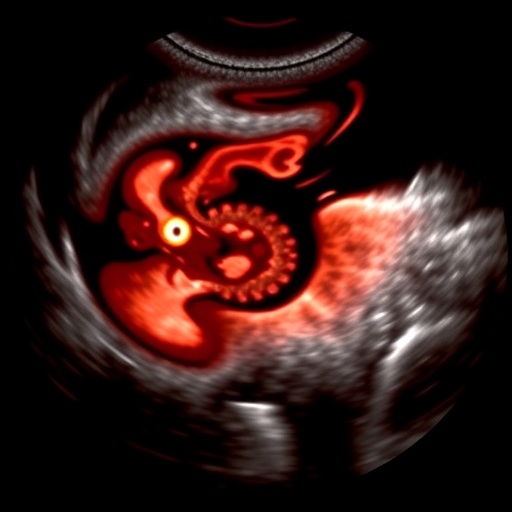In the ever-evolving field of pediatric medicine, new diagnostic techniques are continually shaping our understanding of childhood ailments. Among the various methodologies employed, ultrasonography has emerged as a key tool, particularly in evaluating tonsillar pathology in children. A recent study, led by Koutrouveli and colleagues, offers a groundbreaking comprehensive approach to this often-overlooked area of pediatric radiology. The implications of their findings are profound and could significantly alter the diagnostic landscape for tonsillar diseases in young patients.
Ultrasonography is a non-invasive imaging technique that utilizes sound waves to produce images of internal organs. In the context of pediatric tonsillar assessment, this method presents numerous advantages over more traditional imaging techniques. For instance, it does not involve ionizing radiation, making it a safer alternative for children who are particularly sensitive to radiation exposure. The study spearheaded by Koutrouveli and her team emphasizes that this key advantage positions ultrasonography as a frontline imaging modality in the diagnostic workup of tonsillar conditions.
Tonsillar pathology encompassing various disorders such as hyperplasia, infection, and neoplasms can significantly affect a child’s health and quality of life. The symptoms associated with these conditions, ranging from chronic sore throat to obstructive sleep apnea, can severely impede daily functioning and overall well-being. Understanding the full spectrum of tonsillar diseases and their presentations thus becomes crucial for timely intervention. According to the study, ultrasonography allows for real-time visualization of the tonsils and surrounding structures, enhancing the ability to detect abnormalities that may warrant further investigation.
One of the most striking findings of this research is its emphasis on the ability of ultrasonography to differentiate between various forms of tonsillar enlargement and inflammation. This capability is vital in determining whether the enlargement is due to benign hypertrophy or potentially malignant processes. The authors underscore that a detailed ultrasonographic examination can provide critical insights into the underlying cause of tonsillar pathology, allowing for more informed clinical decision-making.
Moreover, the study highlights that ultrasonography can be particularly beneficial in pediatric populations, where symptoms of tonsillar disease may mimic a range of other conditions. The study delineates how ultrasonographic findings can clarify the diagnosis, assisting clinicians in avoiding unnecessary surgical interventions or referrals to specialists. The implications of this could mean reduced healthcare costs and a more streamlined pathway for children suffering from tonsillar disorders.
In addition to enhancing diagnostic accuracy, the research identifies the valuable role of ultrasonography in monitoring treatment responses. The ability to visualize changes in tonsillar size or characteristics following medical or surgical intervention is a crucial component of patient management. Koutrouveli et al. furnish evidence that regular ultrasonographic assessments can help gauge the effectiveness of therapeutic approaches, thereby aiding in the adjustment of treatment plans as necessary.
The authors caution, however, that while ultrasonography offers numerous benefits, it is not without limitations. Technical challenges such as difficulty in obtaining adequate views due to patient cooperation issues or obesity must be recognized. Additionally, operator experience plays a significant role in the quality of the examination. These points underscore the necessity for training and standardization in ultrasonographic techniques as they pertain to pediatric populations.
Despite the limitations, the potential of ultrasonography in pediatric tonsillar assessment is substantial. As highlighted in the research, the rapid advancements in ultrasound technology, including better resolution and portability, will only enhance its applicability in clinical settings. The authors advocate that ongoing research into the ultrasonographic characteristics of tonsillar diseases could lead to the establishment of standardized protocols that can be universally applied across various healthcare facilities.
Furthermore, the study acknowledges the need for greater awareness among healthcare providers regarding the advantages of ultrasonography in evaluating tonsillar conditions. Education regarding the appropriate utilization of this tool can significantly alter clinical outcomes for pediatric patients. By encouraging clinicians to adopt ultrasonography as a primary imaging technique for tonsillar pathology, we can better address the diagnostic challenges faced by practitioners, ultimately improving the quality of care for children.
In conclusion, Koutrouveli and colleagues have provided valuable insights into the role of ultrasonography in the assessment of pediatric tonsillar pathology. Their findings suggest that this imaging modality holds great promise for enhancing diagnostic precision, improving treatment monitoring, and optimizing patient outcomes. As the study advocates, the path ahead requires increased integration of ultrasonography into clinical practice, coupled with ongoing research to continue to refine its application in pediatric medicine.
The clear benefits of this approach are a testament to the importance of interdisciplinary collaboration in enhancing pediatric healthcare. In an era where technology continuously evolves, the integration of sophisticated imaging techniques like ultrasonography will undoubtedly become a cornerstone in the management of tonsillar diseases in children.
The study by Koutrouveli et al. heralds a new chapter in the understanding and treatment of tonsillar disorders, reinforcing the crucial need for innovative diagnostic strategies in pediatrics. As we reflect on the future, the emphasis on making ultrasonography a staple in the evaluation of tonsillar pathology will serve to ensure that our youngest patients receive the best possible care.
Subject of Research: Pediatric tonsillar pathology and ultrasonographic evaluation.
Article Title: Pediatric tonsillar pathology: a comprehensive ultrasonographic approach.
Article References:
Koutrouveli, E., Panagiotopoulou, A., Sfakiotaki, R. et al. Pediatric tonsillar pathology: a comprehensive ultrasonographic approach.
Pediatr Radiol (2025). https://doi.org/10.1007/s00247-025-06322-2
Image Credits: AI Generated
DOI: https://doi.org/10.1007/s00247-025-06322-2
Keywords: Pediatric tonsillar pathology, ultrasonography, diagnostic imaging, tonsillar enlargement, treatment monitoring.




